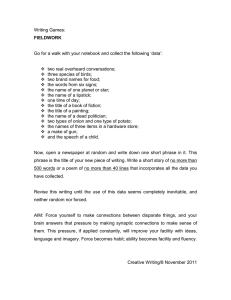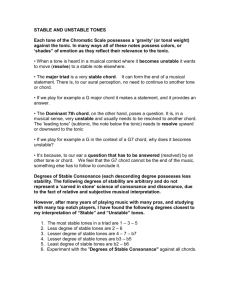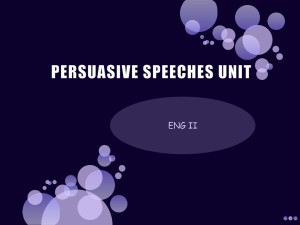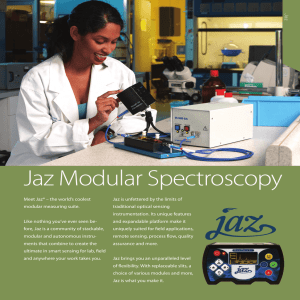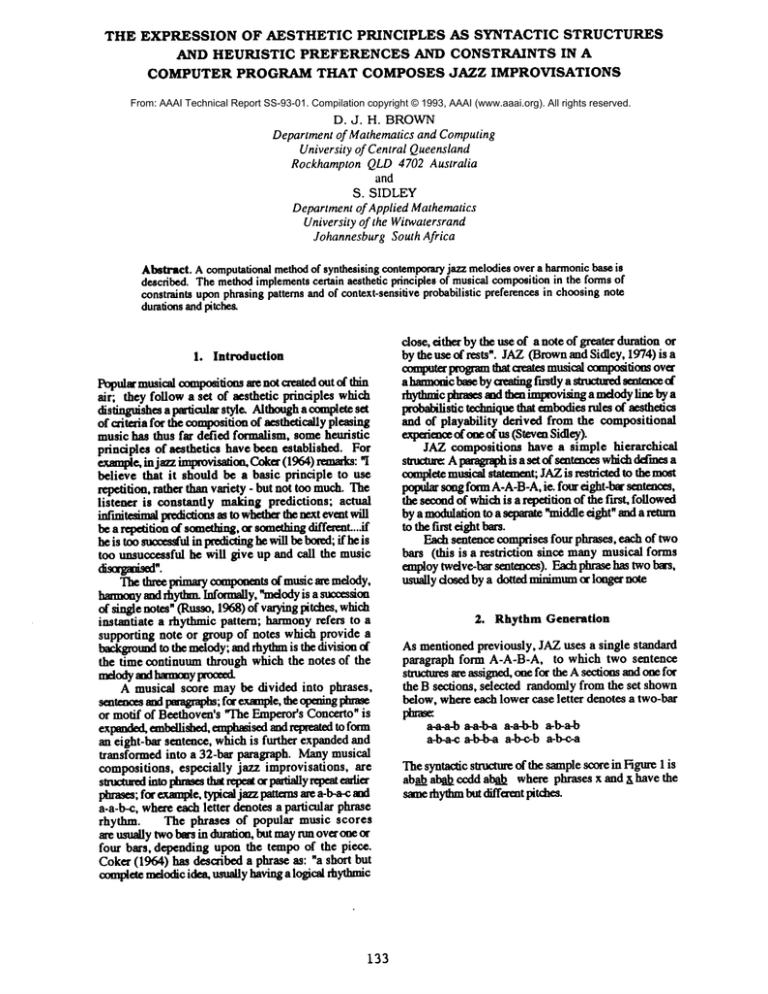
THE EXPRESSION
OF AESTHETIC PRINCIPLES
AS SYNTACTIC STRUCTURES
AND HEURISTIC
PREFERENCES AND CONSTRAINTS IN A
COMPUTER PROGRAM THAT COMPOSES
JAZZ
IMPROVISATIONS
From: AAAI Technical Report SS-93-01. Compilation copyright © 1993, AAAI (www.aaai.org). All rights reserved.
D. J. H. BROWN
Department of Mathematics and Computing
University of Central Queensland
Rockhampton QLD4702 Australia
and
S. SIDLEY
Department of Applied Mathematics
University of the Witwatersrand
Johannesburg South Africa
Abatract. A computationalmethodof synthesising contemporaryjazz melodiesover a harmonicbase is
described. The methodimplementscertain aesthetic principles of musicalcompositionin the formsof
constraints uponphrasingpatterns and of context-sensitiveprobabilistic preferencesin choosingnote
durationsandpitches.
1. Introduction
Popularmusicsl oomposifionsare not created out of thin
air; they follow a set of aesthetic principles which
distinguishes a l~rticular style. Althougha completeset
of criteria for the comlx~tionof aesthetically pleasing
music has thus far defied formalism, someheuristic
principles of aesthetics have been established. For
example,in jazz improvisation,Coker(1964) remarks:
believe that it should be a basic principle to use
repetition, rather than variety - but not too much.The
listener is constantly making predictions; actual
infinitesimal predictiousas to whetherthe next event will
be a repetition of something,or somethingdifferent...if
heis too successfulin predictinghe will be bored;if he is
too unsuccessful he will give up and call the music
The three primary ~ts of music are melody,
harmonyand rhythm Informally, ~dody is a suction
of single notes" (Rnsso,1968) of varying pitches, which
instantiate a rhythmic pattern; harmonyrefers to a
supporting note or group of notes which provide a
backgroundto the melody;and rhythmis the division of
the time continuum through which the notes of the
melodymdtmmny
A musical score may be divided into phrases,
sentences and pmagraphs; for exm~e" the~ phrase
or motifof Beethoven’s
"TheEmperor’s
Concerto"
is
expended,
embellished,
emphasised
andrelxeated
toform
an eight-bar
sentence,
whichisfurther
expanded
and
transformed
intoa 32-barparagraph.
Manymusical
compositions,
especially
jazzimprovisations,
are
sU-uamed
into
phrases
that
repeat
orpartially
repeat
ead/er
phrases; for example"typical jazz patterns mea-b-a-c and
a-a-b-e, whereeach letter denotes a particular phrase
rhythm.
The phrases of popular music scores
are usually twobars in duration, but mayrun over one or
four bars, depending upon the tempo of the piece.
Coker (1964) has described a phrase as: "a short but
completemelodic
idea, usually
having
a logical
rhythmic
133
close’either by thenseof a note of greater duration or
by the use of rests’. JAZ(Brownand Sidley, 1974) is
cougm~programlhat a~,es musical compositions over
a harmonicbase by c:~fing fnsdy a smamaed
sentence of
rhy,hc 0rues
and*,=i,. ovi g a maody
bya
lrobabilistic technique that embodiesrules of aesth~cs
and of playability derived from the compositional
expefien~of one of us (StevenSidley).
JAZ compositions have a simple hierarchical
struetme: A pmagaph
is a set of smtenceswhichdefines a
completemusicalstatement; JAZis restricted to the most
popular song form A-A-B-A,ie. four eight-bar sentinel,
the secondof whichis a repetition of the first, followed
by a modulationto a separate "middleeight" and a telmn
to the first eight bars.
Eachsentence
comprises fourphrases,
eachoftwo
bars(thisis a restriction
sincemanymusical
forms
ea~Ioy
twdve-bar
smtmces).
Eachphrase
hastwobars,
usually dcsed by a dotted minimum
or longer note
2. Rhythm Generation
As mentioned previously, JAZuses a single standard
paragraph form A-A-B-A, to which two sentence
s~ me assigned, one for the A sectiom and one for
the B sections, selected randomlyfrom the set shown
below, whereeach lower case letter denotes a two-bar
phra
a-a-a-b a-a-b-a a-a-b-b a-b-a-b
a-b-a-c a-b-b-a a-b-c-b a-b-c-a
The syntaoic s~ of the sample score in Figure 1 is
abab ab~ ccdd ab~ where phrases x and x have the
sane rhythmbut diff=mt pitches.
3
134
In fine with Coker’sargument,noted previously, phrase
rhythm~ are gezg~Aedby a ~ which tends to duster
shorter notes toward the beginning of the phrase and
longer notes towardthe end. Three classes of notes ate
defined, as shownin Table I (lengths are shownin
parentheses). Utilising a o’otcbet base and common
time
(four beats to the bar), wehaveeight units in each two-
~pt~ra~
short notes
semiquaver
(0.25)
quaver(0.5)
doaedquaver(0.75)
crotchet(1)
crotchetrest (1)
crotchettriplet Ox 0.33)
conventional rules for establishing parent scales and
modular bases (Mehegan,1968). Once a parent scale
has beenselected, the actual degreeof that scale chosenis
a probabilistic function of the duration of the note to be
assigned. The conditional probabilities of notes are
obtained
froma consideration of several constraints
and
preferczgesconcerninothe aesthetics of hazmony
and the
physical limitations of musicims.
JAZ distinguishes three types of note within the
associated scale of any chord: these are the basic tones,
the sensitive tones end the destrt~ve tones. Basic tones
always
sound"comx~"~t a given chord;thesenotes
arc those of the chord itself. For example,the C triad
comprises the notes C-E-G. Anyof these notes maybe
played in the melody against a C triad harmony.
Sensitive tones are those notes of the scale that are not
theoretical inadmissablebut whichcreate an intangible
tension, as if waitingfor resolution. Destna:fivetones am
those notes of the scale that, whensustained for too long
against a given chord, tend to destroy the
"impl/cafion" of tbe chonf Forexam~e,
a G major
chord
"implies" a Groot, whereasits eleventh tends to reduce
the feeling of a G tonality. Table 2 details the basic,
sensitive and destructive tones for various chordtypes.
It will be noted that the sixth of a minorchordis taken
from the harmonic minor scale or the melodic
minor scale ~n~ on the modal base of the meledy.
medium notes
dotted
crotchet
(1.5)
minim(2)
minim
rest (2)
minim
triplet
(3x 0.67)
long notes
dotted minimO)
dottedminimrest O)
semibreve(4)
semibreve
rest14~)
TABLE1
Thethree classesof rhythmic
entities.
JAZproceeds through a phrase from beginning to end,
selecting notes in the followingnumne~.L~ b deao~the
~t position within a phrase; then the probability of
selectinga notein a particularclass is:
medium
Io ng
short
low
1 .=b<3 high
3 =; b < 5 high
high
low
low
high
5 .~ b < 7
7<b: a short noteis neededto fill the phrase(wecould
of coursehavefilled phrasesbackwards
to ensurethat a phrase
is alwaysclosedbya longnote,but wepreferto allowthe
occasionalclosureby a short note).
3. Melody Generation
Melodylines are assigned, one to each sentence, on a
probabilistic basis within the aesthetic and playability
constraints detailed below. Although any phrases
repeat~ within a sentence will have the same rhythmic
structure, their melodylines c, aa differ. In general, the
melody
is allowedto range over three octavesfounded
by
the tonicof thefirstchordof theharmony.
For
anygivenchord(tlmharmony
comprises
onechordper
bar), a related or parent scale is assigned.In general,
chord maybe related to more than one scale; this is
resolved by choo~ngthat pertaining to the key in which
the music is written, or, when appropriate, to the
modular base of a particular section. JAZuses the
135
Basic Sensitive
Destructive
Major
2,6,7
4
1,3,5
Major7th
1,3,5,7
2,6
4
4
Major Oh
1,3,5,6
2,7
Minor
1,3,5
2,6,7
4
Minor7th
1,3,5,7
2,4
6,7
2,4
F
Minor6th
1,3,5,6
Dominant701
1,3,5,7
2
4,6
Dominant9th
6
4
1,2,3,5,7
Augmenmd
1,3,5
Diminished
D
D
1.3.5
(notes:
I represents
firsL 2 second
etc.
Dreim~sentsthe dominant
of the next chord.
F represents
the
flattened
fifth
I
TABLE2
Degrees
of Scalesfor differenttoneclassea
The above considerations are reflected in JAZby the
followingrule: if a note is of very short duration, all
notes in the parent scale are equally probable; the
longer the note, the less likely destructive or sensitive
tones will be chosen. Table 3 displays the exact
probabilities
used. Dotted notes take the same
probability as the note 2/3 its duration (eg. dotted
trocheetakesthe same~ty as a~,tche0.
semkluave:
quaver
c .m~.her
immtm
lsemibreve
Basic
0.4
0.4
0.6
0.9
0.9
Sensitive
0.3
0.3
0.3
0.1
, 0.1
grammar
to create certain patterns of rising or falling
Destructive
0.3
0.3
O.1
0
0
we a te,
TABLE3
Probabilityof assigninga particular tone class,
as a functionof duration.
As it is intended that JAZcompositionsbe playable on
conventional instruments, their natural limitations
are brought into account. Whenan instrumentalist is
playing a very fast passagehe is limited in the size of
interval jumpsthat he can make,due to finger and/or lip
control problems.Consequently,a fast passageshould be
a sequence of small interval jumps, whereasa slower
passage is moreable to cs~ompasslm’gejumps(with the
overall limitation of one octave). The maximum
jumps
allowed in J~ ~’e shownin Table 4.
Duration of
previous note
~nuquaver
quaver
cpotchet
minim
semibreve
Maximumjump
allowed
major seco~
majorthird
fourth
octave
octave
TABLE4
Allowedinterval jumps
4.
mque to
notes fromwithin the scale associated with the harmony.
JohnsonLaird uses "a grammarwith relatively limited
computational
powerto generate the bass-line" (Boden,
1991. p156), whereas JAZuses a harmony (ie chord
~quence)provided to it- JAZis not the sole creator of
themusical
ideabehind
a score
(which
resides
largely
in
theharmonic
construction
supplied
toit),butitisthe
c~’~_
:,~ofvarim/om
~ thattheme.
Fromthe point of viewof the listener, it could be
argued that the "meaning"of a piece, in the sense in
which that term is used by Minsky (1989), mayhave
moreto do with the contours of the harmonythan of the
rhythmand mdodyJAZimprovises upon it; the harmony
defines the theme and the rhythm and melodydefine a
variation. Nonetheless, when another musician was
shownthe sample score
andasked to improvise further
uponit, and did so,he afterwardremarkedthat he felt he
was as muchinfluenced by the colour of the melodic
phrasing that JAZhad improvisedas he was by the basic
harmony, l~ahn (1989) remarks: "rhe notion
representation remains intriguing .... the kind of nonverbalisable representation that occurs, even in my
listening mind, gathering each specific aspect of a
performanceinto a wholethat is greater tlmn the sumof
itsparts, endowing
everymusicalpart witha strongly-cast
supportingrole in the emergentdmaoerof that piece or
perform~ce.If these representatious are not inherently
nonverbalizable, a theory dealing with them wouldbe
both possibleand mostinte:esfing".
The syntactic structures that JAZ uses are 2dimensional(harmonyand rhythm).It is fair to say that
the true dime~onalityof musicalstruox~ is (at least)
dimensional(ie,including
mc/ody).
Ourmeth~
ofusing
empirically-derivedhcmisticprcfaeuces(probabilities)
and
~ostraints to improvise a melodyline captures someO~g
of the essenceof musicalaesthetics and seemsto workup
to a paint, but we wouldnot care to claim that we know
just wherethat point is nor whatties beyondit.
Conclusions and Confessions
JAZrelates phrases only whenthey are rhythmically
similar; many other relations (contour, partial
repetition, paraphrase, embellishmentetc.) need to be
considered. Other compositional factors as yet
missing f~i JAZinclude the use of deliberate unresdved
dissonanceto create effect, passing non-chordtones and
the introduction of more complexrhythmic structures
(eg. offbeat triplet dusters). Furthermore, as JAZ
intended to produceonly popular style melodies,complex
modesand scales found in modemclassical music and
centmVcv~jazz have been omitted.
TheVallOUS
pal’alnet~pl~3]~bifities usedin JAZwere
initially basedon the compositional
experience
ofoneof
us(Sidley);
astesting
progressed
these
probabilites were
tuned so that the generated compositionsapproximated
moredosely our personal aesthetic criteria for pleasing
melodies. Possible extensions to JAZinclude automatic
harmonygeneration, computer generated voicings of
given chords to enhancethe melodyto maximum
effect,
central melodies and ov:hemafon.
Webecame aware of the work of Johnson-Laird
(1989) last year, whichappears to take the samebroad
approach of creating a melodyline as a function of
harmonyand rhythm. Johnson-Laird uses a generative
References
Boden,M. (1991) The Creative Mind: Myths and
Mechanisms,
Weidenfeldand Nicholson.
Brown,D.J.l-l. and Sidley, S. (1974)AComputational
Model
of Jazz Improvisation. Technical Report, Dept of
AppliedMathematics.
Universityof the Witwatersrand.
Coker,J.(1964)ImprovisingJazz, Prentice-Hall.
Johnson-Laird,EN.
(1989)JazzImprovisation: A Theory
the Computational
Level. Unpublished
Working
Paper.
Mehegan,J. (1968) Jazz Improvisation,
Simonand Schuster.
vol. 2.
Minsky,M.(1989) Music, Mindand Meaning.In: Roads.C.
(ed.): TheMusk:Mac/n’ne,MITPress, 639-655.
Rahn,J. (1989) OnSomeComputationalModelsof Music
Theory. In: Roads,C. (ed.): The Music Machine,
MITPress. 663-669.
136



